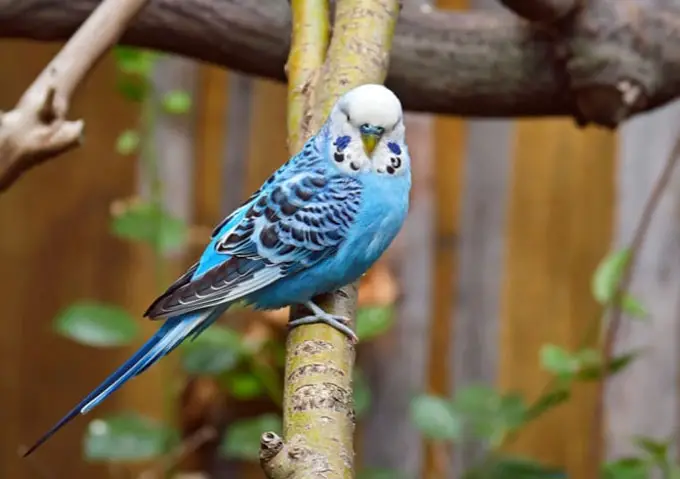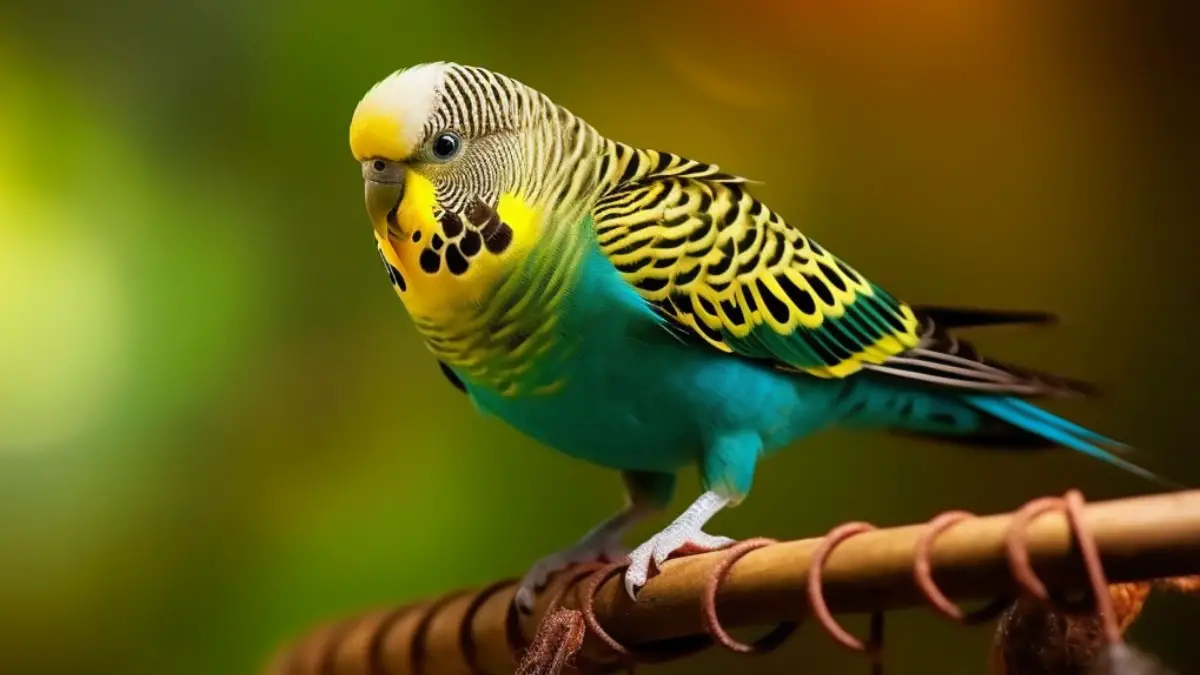Molting is a process in which old feathers fall out, and new ones grow in their place. This process is cyclical and typically occurs once a year.
This process helps budgies to maintain their plumage and keeps them warm. It also allows birds to replace damaged or worn-out feathers, which can affect their ability to fly and maintain proper balance. Feathers provide insulation, protect them from the elements, and are important parts of bird anatomy.
As feathers fall out and new ones grow in, you may notice several symptoms. Your budgie may become more vocal or withdrawn. You may see an increase in preening behavior as the bird works to maintain its feathers’ health. Additionally, you may notice changes in your bird’s appetite or digestion.
So, how to help a molting budgie? You can do so by ensuring proper diet, and hydration, providing comfortable perches, and avoiding stress. You should also have a firm knowledge of the common symptoms of molting, such as feather loss and irritation. Because it’s essential in pet care if your pet is a bird.
In this article, we will provide you with some tips on how to help your budgie through molting. We will discuss ways to provide extra nutrition, comfort, and care to help your bird grow new feathers quickly and easily.
Managing Budgie Molting Symptoms

Molting is a natural process that birds go through to replace their old feathers with new ones. During this time, birds may experience a range of symptoms that can be uncomfortable and distressing.
All the budgie species and breeds go through the molting process. Budgie is one of the 115 species of Parakeet.
As a responsible pet owner, it’s important to know how to manage these symptoms in supporting a budgie during molting.
Common Symptoms of Molting

The symptoms of molting can vary depending on the individual bird and the stage. However, some common symptoms include the following:
- Feather loss: As new feathers grow, old feathers may fall out, leading to patches of bare skin.
- Itching and irritation: The growth of new feathers can cause discomfort and itchiness, leading to excessive scratching and grooming.
- Decreased appetite: Some budgies may experience a loss of appetite during molting. That’s because the energy required for feather growth can take a toll on their overall health.
Providing Relief for Itching and Irritation
One way to help your budgie manage itching and irritation during molting is to provide them with opportunities to bathe.
A shallow dish of water can be placed in their cage for tirritationhem to splash around in. Besides, you can use bird grooming tools like bird bath sprays. This can help to soothe their skin and feathers and make them more comfortable.
Preventing Self-Plucking and Destructive Behaviors

Some budgies may develop self-plucking or other destructive behaviors during molting, such as:
- Picking at their feathers
- Chewing on their skin
This can be a serious problem that can lead to infections and other health issues.
To prevent this behavior, it’s important to provide your bird with plenty of stimulation and distraction during this time. This can include toys, perches, and other forms of enrichment.
Monitoring Your Budgie’s Behavior and Health
Finally, it’s important to closely monitor your budgie’s behavior and health during molting. Look for any signs of distress, such as excessive scratching or plucking, and make sure they are eating and drinking enough.
If you notice any concerning symptoms or behaviors, it’s best to consult with a veterinarian. He can help you develop a plan for managing your bird’s symptoms.
Proper Nutrition for Molting Budgies

Molting is a period of high nutritional demand for birds as they need to produce new feathers. Feeding a molting budgie a balanced and nutritious diet is essential to support feather growth.
Nutritional Requirements of Molting Budgies
During molting, bird food types should be high in protein, fat, and vitamins.
- Proteins provide the necessary building blocks for feather growth.
- Fats provide energy and support skin and feather health.
Vitamins, especially vitamin A and B complex, are important for feather development and overall health.
- Pet bird nutrition involves vitamin A for various essential functions, such as:
- Maintaining their eyesight
- Regulating hormones
- Supporting their immune system
- Additionally, vitamin A facilitates molting by promoting the production of sebum, a natural oil that moisturizes the skin and feathers.
- Among the crucial B vitamins,
- Thiamine (Vitamin B1) helps to reduce stress and prevent feather plucking by relieving itchiness caused by pin feathers.
- Riboflavin (Vitamin B2) supports healthy skin and feather growth
- Niacin (Vitamin B3) is necessary to provide sufficient energy for budgies during the process.

Here is a suggestion for different types of food with different nutritional facts for your budgie during molting.
| Nutrition Type | Food |
|---|---|
| Vitamin A | Carrots, sweet potatoes, spinach. |
| Vitamin B1 | Beans, lentils, green peas. |
| Vitamin B2 | Egg, leafy green vegetables. |
| Vitamin B3 | Whole grains, mushrooms. |
| Vitamin C | Broccoli, peppers, kiwis. |
| Protein | Egg, chicken, legumes. |
| Fat | Sunflower seeds, pumpkin seeds, sesame seeds. |
| Iron | Berries. |
| Zinc | Almonds, cashews. |
| Calcium | Cooked eggs with shells, leafy greens. |
| Magnesium | Spinach, brown rice. |
Adjusting Your Budgie’s Diet During Molting

You can adjust your bird’s diet during molting by incorporating more high-protein foods, such as:
- Eggs
- Chicken
- Legumes
It’s also important to ensure that your budgie has access to various fresh fruits and vegetables to provide vitamins and minerals.
Importance of Hydration During Molting
Proper hydration is crucial during molting as it helps to keep your budgie’s skin and feathers healthy and supple. Ensure that your bird has access to fresh water at all times. Furthermore, consider adding a water dish or fountain to encourage drinking.
Offering Supplements to Support Feather Growth
In addition to a balanced diet, you may consider offering supplements to support feather growth and overall health. Nutritional supplements such as vitamin A and B complex and omega-3 fatty acids can help promote healthy feather growth. Moreover, they will be great for reducing inflammation.

Besides, it’s important to ensure that your bird’s diet also includes
- Calcium
- Magnesium
- Iron
- Zinc
- Vitamin C
You can provide these essential nutrients through both food and supplementation. Leaf veggies, shelled eggs that are fully boiled, and the occasional treat of nuts are excellent food choices.
Creating a Comfortable Environment for Your Budgie During Molting
This step during molting is essential for bird health and well-being because It can be a stressful time for birds. However, you can help them feel safe and comfortable with a few adjustments to their environment.

Adjusting Lighting and Temperature
During molting, it’s important to provide your budgie with a consistent and comfortable temperature and lighting environment. This can help promote feather growth and prevent stress.
- Keep the temperature in their living space around 70-75°F.
- Avoid placing their cage near windows that get direct sunlight as this can cause temperature fluctuations.
Providing Appropriate Perches and Toys
Perches and toys are important for comforting a molting budgie and its activity levels. Make sure that their perches are a suitable size and shape to promote proper foot health and encourage movement.
Offer a variety of bird toys and accessories that promote physical activity and mental stimulation, such as swings, bells, and puzzles. Avoid offering toys that could potentially damage their feathers, such as those made of abrasive materials or with sharp edges.
Encouraging Preening and Feather Maintenance

Preening is an important part of feather care and bird grooming that keeps feathers healthy and shiny. During molting, it’s important to encourage preening and make sure that your budgie has access to materials to help them groom. This includes:
- Cuttlebones
- Mineral blocks
You can also mist your bird with water to help soften its feathers and make preening easier.
FAQs
Let’s look at a few more additional questions related to the above discussions.
Ans. Budgies undergo a molting process once a year, although some may shed more often. The duration differs from bird to bird, but it typically takes around 2-3 weeks. During this period, budgies may seem untidy and unkempt as they regenerate their feathers.
Ans. Yes, molting can affect a budgie’s behavior. During the process, budgies may feel uncomfortable or itchy as their old feathers fall out and new feathers grow in. This can cause them to be irritable and more prone to biting or aggression.
Additionally, it requires a lot of energy from the bird’s body, so it may be more lethargic or less active than usual.
Ans. Yes, it is normal for budgies to lose a significant amount of feathers during molting. During the process, birds shed their old feathers to make way for new ones to grow. This shedding can result in a significant amount of feather loss.
Ans. If your budgie is experiencing persistent symptoms during its molting phase, you should seek assistance from veterinary care for birds. A veterinarian can help identify any bird health problems that may require attention.
During this time, it is important to provide your bird with a quiet and peaceful environment for resting. This can be achieved by allowing it to sleep for at least 12 hours a day. Also, pay proper attention to the diet.
Ans. Here are some signs to look out for that indicate your budgie may be getting ready to molt:
- Your bird may start to lose feathers around its head, neck, and wings.
- It may become more irritable or moody as it begins to lose its feathers.
- You may notice pin feathers starting to grow in place of the old ones that your bird has lost.
- It may spend more time grooming and preening itself as it sheds its old feathers and grows new ones.
Conclusion
Molting is an essential process for budgies that occurs once a year. It involves shedding old feathers and regrowing new ones. To ensure the health and well-being of your bird during this time, it’s crucial to provide proper nutrition. Moreover, a comfortable environment and supportive care are also necessary.
Budgies may experience common symptoms such as feather loss, itching, and irritation. Bird behavior monitoring is very important during this phase if you want to be a responsible owner.
Incorporating high-protein foods, ensuring adequate hydration, and offering supplements are essential for supporting feather growth and overall health. Creating a comfortable environment that includes appropriate perches and toys is highly encouraged. Moreover, encouraging preening and feather maintenance can also support your budgie’s comfort.
For further understanding of buddies’ health, you can do some self-studies and research for resources. You can consult with an avian veterinarian and explore credible online resources. Taking care of your bird during molting can ensure they stay healthy, comfortable, and happy.







